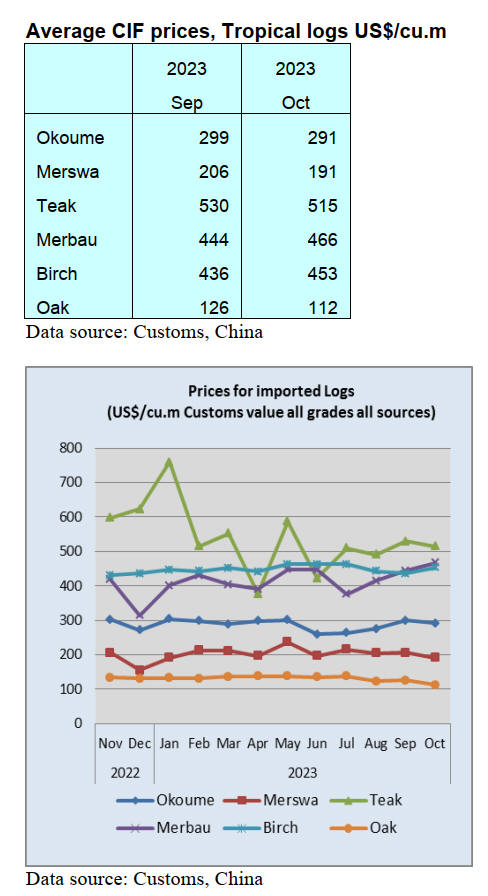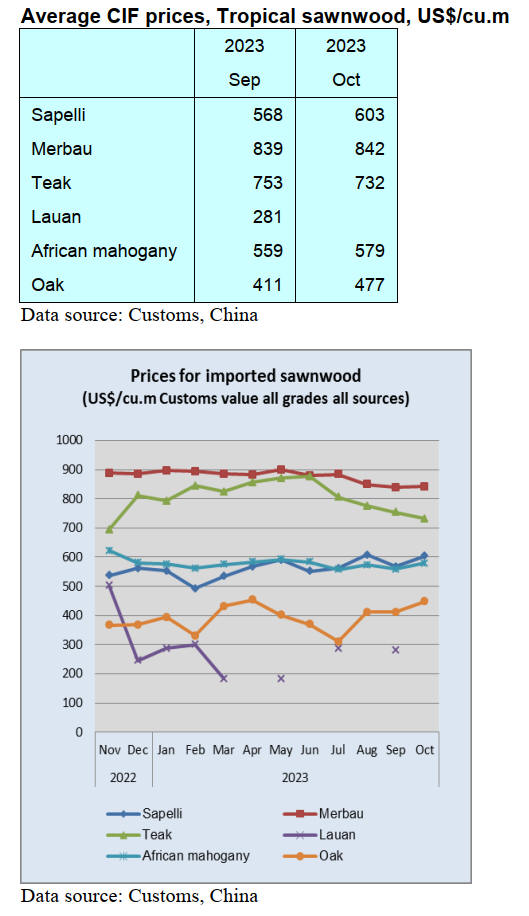US Dollar Exchange Rates of
25th
Nov
2023
China Yuan 7.15
Report from China
Signs of
recovery are mixed
Consumer prices fell in October after briefly leveling out,
a sign that consumers remain cautious despite the
government stimulus measures. Also, producer prices fell
for a 13th consecutive month, dropping 2.6% year on year,
against a 2.7% decline forecast by economists and
following a 2.5% contraction in September.
China’s economy has shown mixed signs of recovery in
recent months leading economists to debate whether it will
hit the government’s GDP growth target this year of 5%,
the lowest in decades. Prices fell into negative territory in
July before edging back into growth in the months that
followed.
The IMF has upgraded its forecast for China’s GDP
growth to 5.4% citing stronger support from policymakers
who have been easing monetary policy and easing
restrictions on property purchases and mortgages to try to
stabilise the real estate market.
Consumer Price Index for October 2023
The National Bureau of Statistics released the October
consumer price indices which show the national consumer
price index (CPI) decreased by 0.2% year on year. Prices
in urban areas decreased by 0.1% and prices in rural areas
decreased by 0.5%. The price of food decreased by 4%
and prices for consumer goods dropped by 1.1%.

Group standard on carbon footprint accounting
Eleven departments, including the Standardisation
Administration of China, the National Development and
Reform Commission and the Ministry of Industry and
Information Technology jointly issued the Guidelines for
the Construction of a Carbon Peak and Carbon Neutral
Standard. The Carbon Peak and Carbon Neutral Standard
system was structured around basic universal standards as
well as the development needs for carbon reduction,
carbon removal and carbon market development.
A Technological Specification for Carbon Footprint
Accounting for Timber Products was recently published
with aim of responding to national policies and promote
systematic construction of carbon peak and carbon neutral
standard system. The Standard number is T/TSNR002-
2023. This Standard is China's first carbon footprint
accounting standard for timber product.
The release of this standard makes up for the gap in the
field of carbon footprint accounting for wood products and
improves the transparency and consistency of the
evaluation and notification of carbon footprint accounting
for wood products to help enterprises better understand the
carbon footprint of their wood products to achieve targeted
carbon reductions.
Promoting bamboo as a substitute for plastic
It has been reported that a three-year Action Plan to
accelerate the development of "Bamboo as a Substitute for
Plastic" has been released by the National Development
and Reform Commission (NDRC) to provide direction,
specific measures and support policies for the
development of "replacing plastic with bamboo" in various
industries and is a guide for achieving green and
sustainable development of the industry.
The Action Plan proposes that players in the upper, middle
and downstream industrial chain for "raw materials,
processing and marketing are encouraged to expand in
major bamboo producing areas and commercial and trade
enterprises are encouraged to cooperate with bamboo
product enterprises in production and marketing and
supply and demand matchmaking.
The furniture sector should speed up the formulation and
improvement of bamboo furniture standards and open up
the boundaries of the industry, cooperate with household
appliance makers and building materials and decoration
industries to build an ecological standard system for
bamboo products.
It is necessary to strengthen the two-way cultivation of
production and consumption and encourage enterprises to
develop more practical and environmentally friendly
furniture products such as bamboo desks and chairs,
bamboo shoe racks, bamboo lamps and lanterns and guide
consumers to choose more high-quality and low-carbon
bamboo furniture and household goods.
It is necessary to explore the construction of furniture "old
for new" and recycling systems with relevant national and
local departments, reduce the cost of furniture product
renewal and increase the proportion of bamboo furniture
products.
The furniture industry is encouraged to focus on leading
enterprises and areas with rich bamboo resources and
build world-class bamboo furniture production enterprises
and bamboo furniture industry bases.
See:
https://www.ndrc.gov.cn/xxgk/zcfb/tz/202311/t20231102_1361715_ext.html
Surge in sawnwood and log imports from Sweden
According to data from China Customs, wood product
imports from Sweden totalled over 905,000 tonnes in the
first half of 2023. China’s imports from Sweden were
wood pulp (41%), timber products (35%) and paperboard
and paper products (23%).
China’s wood pulp, timber products, paperboard and paper
products imports were about 375,000 tonnes, 320,000
tonnes and 210,000 tonnes valued at US$333 million,
US$123 million and US$219 million respectively.
Most of the solid wood products imported from Sweden
were sawnwood (83%) and logs (16%) valued at US$108
million and US$10 million, surging 86% and 240% year
on year in volume in the first half of 2023.
Decline in China’s plywood exports to Sweden
According to China Customs, China’s wood product
exports to Sweden totalled over 23,000 tonnes in the first
half of 2023. About 92% of China’s exports to Sweden are
wood products (50%), paperboard and paper products
(34%) and furniture seats (9%). China’s paperboard and
paper products, furniture and seats exports to Sweden were
about 12,000 tonnes, 8,000 tonnes and 2,000 tonnes
valued at US$25 million, US$27 million and US$45
million respectively.
China’s furniture and seats exports to Sweden rose 5% but
China’s wood products, paperboard and paper products
exports to Sweden fell 26% and 27% respectively in the
first half of 2023.
China’s plywood exports to Sweden fell 26% to 12,000
cubic metres valued at US$6.93 million, down 27% in the
first half of 2023.
Other wood product exported to Sweden include clothes
hangers, disposable wood sticks (HS code 4421, 20%),
wooden tableware, kitchen utensils (HS code 4419, 9%),
wooden frames for drawing, picture or mirror (HS code
4414, 7%), down 21%, 37% and 17% respectively.
Inner Mongolia's "made in Ulanqab" furniture exported
to Russia
Finished furniture made in Ulanqab City, Inner Mongolia
Autonomous Region are being exported to Russia on the
China-Europe train for the first time, the destination is
Russia’s Yekaterinburg. 24 categories of furniture were
shipped such as sofas, beds, dining tables and chairs which
were customised according to the needs of Russian
customers.
Chinese enterprises imported timber from Russia to
Ulanqab through the China-Europe freight train for
processing into furniture products and then re-exported
these items to Russia and other countries. Chinese
enterprises have a large number of customers in Russia.
Chinese enterprises will rely on the China-Europe freight
train and Ulanqab's geographical and resource advantages,
strengthened industrial advantages and extended industrial
chain to provide impetus for cross-border, cross-regional
and cross-field industrial cooperation in the future.
More local products from Ulanqab will be exported to
create new patterns of foreign trade in Ulanqab City.
Since the first China-Europe freight train was launched in
Ulanqab city in 2016 the development of the train service
has been continuously improved. Since the beginning of
2023 the total number of China-Europe freight trains from
Ulanqab City was 114 trains with 4,690 carriages, up
200% year-on-year with a total cargo value of US$203
million and a total cargo weight of 63,200 tonnes. This has
provided a solid foundation for Ulanqab City to actively
participate in the construction of the China-Mongolian-
Russia Economic Corridor.
Global Legal and Sustainable Timber Forum
As part of the implementation of the Legal and Sustainable
Timber Forum (LSSC) Programme and in response to
demands from the global timber industry, ITTO
and the Macao Trade and Investment Promotion Institute
(IPIM) entered a Collaborative Framework Agreement to
co-host the Global Legal and Sustainable Timber Forum to
accelerate building Legal and Sustainable Forest Products
Supply Chains to promote legal and sustainable (“green”)
forest products supply chains and increase the trade in
legally and sustainably produced forest products.
The Forum was held 21-22 November 2023. After two
days of extremely interesting presentations and
discussions, consensus emerged among participants on key
strategies to promote the legal and sustainable
development of the global timber industry and accelerate
its recovery. These included nine key actions.
Forum statement
Timber is a crucial material for a sustainable future
according to 700 participants from governments,
enterprises, international organizations and research
institutions at the inaugural Global Legal and Sustainable
Timber Forum (GLSTF) which issued a set of nine actions
to ensure the stability of the timber sector’s future based
on legal and sustainable forest management and supply
chains.
The aim of the Forum, which was convened jointly by
ITTO and the Global Green Supply Chain Initiative and
the Macao Trade and Investment Promotion Institute was
held in Macao SAR, China, 21–22 November 2023 and
brought together key players in the global timber sector
and mapped a course for the sector’s future sustainable
development.
“Timber is an environmentally-friendly, renewable,
carbon-storing, recyclable material and thus a pillar of
sustainability when produced, processed, traded and used
legally and sustainably,” said ITTO Executive Director
Sheam Satkuru during the Forum. “We believe in the
benefit of bringing all stakeholders in the sector together
because forests and timber are vital for the planet’s
future.”
The world is facing many challenges, such as economic
volatility stemming from the aftermath of the COVID-19
pandemic, global conflicts, trade wars, rising energy
prices, climate change, biodiversity loss and resource
pressure. But Forum participants agreed that such
challenges present opportunities for timber to become a
cornerstone of circular bio-economies.
A sustainable and resilient timber industry, it was asserted,
would not only contribute to wealth creation but also
support healthy lifestyles and reduce the risk of climate
change. The sustainable use of timber can also help
safeguard other forest services, such as conserving
biodiversity, soil and water, storing carbon, preventing
land degradation, and reducing the risk of disasters.
After two days of extremely interesting presentations and
discussions consensus emerged among participants about
key strategies to promote the legal and sustainable
development of the global timber industry and accelerate
its recovery. These include the following nine key actions:
1) Strong networks and partnerships: there is an urgent
need for strong networks and partnerships built on mutual
respect and trust to support legal and sustainable forest
management and timber supply chains.
2) Nature-based solutions: building and improving legal
and sustainable timber supply chains should be recognized
as key nature-based solutions from local-to-global
challenges.
3) Trade promotion: the trade of legal and sustainable
timber products should be promoted to facilitate a stable,
fair, transparent and predictable environment for the
recovery and growth of the global timber industry.
4) Global Legal and Sustainable Timber Forum: the
Forum is a necessary platform for scaling up cooperation
and information exchange between the public and private
sectors and should be held annually.
5) The Global Timber Index: this initiative, which has
been piloted for about a year and was officially launched
at the forum, improves the quality and regularity of timber
market information, encouraging greater information
exchange in the private sector, and enhancing the
efficiency of policy formulation. It should be continued
and scaled up.
6) Advanced technology and traceability: the use of new
technologies, tools and methodologies should be
encouraged to help ensure the legitimacy and
sustainability of timber resources, including the
implementation of sustainable forest management and
digital timber traceability.
7) Financial mechanisms: innovative financial
mechanisms, such as payments for ecosystem services,
should be further developed and used to increase
investment in support of sustainable forest management
and sustainable supply chains.
8) Timber industrial parks: legal and sustainable timber
industrial parks should be established to incubate
enterprises as models for the wider industry, thereby
accelerating the adoption of best practices and advanced
technologies.
9) Support: the global timber industry requires more
support for adopting advanced technologies as a means for
accelerating its sustainable development.
At its conclusion the Forum urged participants to continue
working together by connecting, cooperating and sharing
knowledge. The inaugural GLSTF, planned as an annual
event, has emerged as a cornerstone for building this
global network.
See:
https://www.itto.int/news/2023/11/24/global_forum_calls_for_action_to_sustainably_develop_timber_sector/


Through the eyes of industry
The latest GTI report lists the challenges identified by the private
sector in China.
See:
https://www.itto-ggsc.org/static/upload/file/20231121/1700552181514582.pdf
|